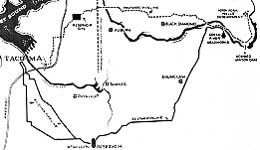In 1963, the Tacoma Water Department proposes that a second pipeline, 30 miles long, be built to carry water from the Green River to Tacoma. The project includes a 10-million-gallon storage tank at the headworks and a 50-million-gallon reservoir in Federal way. Planners anticipate that the project will be completed in 1981, but environmental concerns and other problems delay the project until 2004. The pipeline will end up being 34 miles long and will be completed in 2005.
Pipeline No. 5 was designed to supplement Pipeline No. 1, which was built in 1912. The new line would cross southern King County and fill the reservoir in Federal Way where the water would be treated for turbidity (tiny particles that cloud water). The Tacoma Water Department purchased property for the reservoir in 1967. In 1970, a large aquifer (a water-bearing stratum of permeable rock) was discovered in North Fork Valley in the Green River watershed that would provide clear water during the spring thaw, when turbidity was the greatest problem. In June 1978, the North Fork wells were completed along with 6.5 miles of pipe.
The main pipeline became entangled in disputes with King County and with property owners over road and stream crossings. The original environmental impact statement had to be redrawn, but this did not satisfy King County, the Muckleshoot Tribe, or sport anglers. As the various issues wound their way through the media, administrative reviews, and courts in the 1970s and 1980s, the project stalled. Drought conditions in 1987 and in 1992 underscored the need for more water for Tacoma.
The population of South King County continued to grow and the Tacoma Water Department offered to sell water to the new communities. The project was renamed Second Supply Pipeline and included Kent and, for a time, Seattle. The development of a technology called Oasis allowed the Water Department to store water in an aquifer at Federal Way.
By 1998, all the parties who had blocked the project settled, but then the Puget Sound Chinook salmon was listed as an endangered species, delaying things further. Everything seemed on track in 2000 when the Seattle City Council approved participation for a one-third share of the water at a cost of $80 million. Seattle backed out in 2002 when it disapproved of using water from a watershed open for recreation.
Sections of what grew to be a 34-mile pipeline were completed in five sections, with the final section completed in August 2005. It is expected to provide 65 million gallons of water a day. The cost of the pipeline was $245 million.

